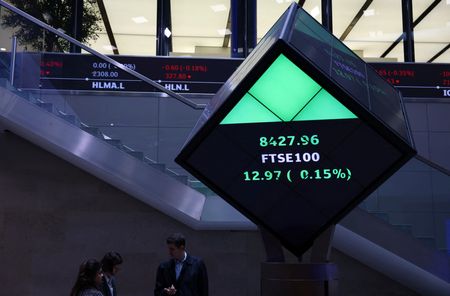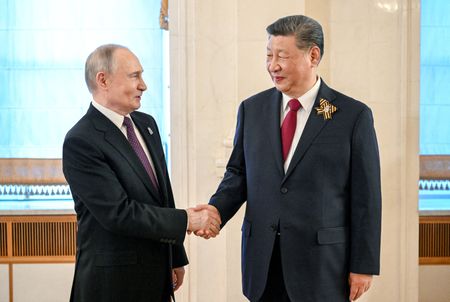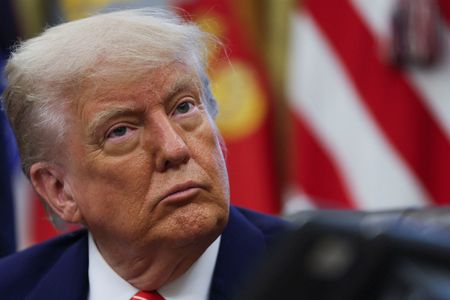By Naomi Rovnick
LONDON (Reuters) -Investors are betting on long-depressed UK markets as a U.S. trade deal, rate cuts and hopes for renewed links with Europe spur optimism for a revival as they search for alternatives to a volatile Wall Street and flailing dollar.
Britain’s FTSE 100 share index completed its longest daily winning streak of all time this month and is now moving in line with international peers for the first time since 2021, while sterling sits near 38-month highs against the dollar.
Money managers expect at least more stability for UK assets scarred by Brexit, ex-Prime Minister Liz Truss’ 2022 mini-Budget scare and January’s bout of capital flight as soaring bond yields threatened shaky government finances.
A UK-EU summit, bets for Thursday’s Bank of England rate cut to be followed by more easing this year and a wider move into Europe and Asia by investors spooked by potential tariff hits to U.S. growth are also sweeping gloom out of British markets.
“These are all marginal benefits that together add up into something bigger,” said Invesco global head of asset allocation research Paul Jackson, who sees UK stocks outperforming the U.S. this year.
The FTSE is up just over 4% this year, while the broad S&P 500 index is down almost 4%.
Jill Hirzel, senior investment specialist at London-based Insight Investment, said the 626 billion pounds ($834.27 billion) asset manager expected 30-year gilt yields, which underpin UK government borrowing rates, to likely drop from current levels around 5.2%. When bond yield falls, their price rises.
TRADE HOPES
U.S. President Donald Trump, who unleashed market turmoil with universal levies on April 2 before pausing most of those, on Thursday unveiled a trade agreement with the UK.
Britain’s car industry will see U.S. tariffs immediately slashed to 10% from 27.5%, while levies on steel and aluminum will reduce to zero.
In late London trade, the domestically-focused FTSE 250 index was up 0.6%.
The UK was already viewed as unlikely to be targeted by punitive import taxes, Fidelity International portfolio manager Shamil Gohil said, but a clear trade deal would lift market and economic sentiment from here.
“It reduces uncertainty, with clarity on tariffs helping to give confidence to businesses and consumers to start spending and investing,” Gohil added. “We could even see a GDP bump because of it.”
British Prime Minister Keir Starmer also wants annual UK-EU summits to follow talks in London on May 19, which will focus on defence partnerships but could set the scene for renewed cooperation in areas like youth mobility and labour.
STABILITY?
UK assets have been on a rollercoaster ride for years, with the latest selling spree in January pushing sterling to 14-month lows and 10-year gilt yields to 17-year highs as fiscal and market stability fears fed on each other.
A brief market rally alongside the labour government’s landslide election win last year faded fast as investors stayed cautious on British assets layered with extra risk after the 2022 rout and 2016 Brexit vote.
Heightened U.S. trade uncertainty, however, which has sparked anxiety about growth slowing and inflation rising and shaken faith in U.S. assets, means Britain appears relatively steady.
“I think the political volatility (in the UK) continues, but hopefully from an international perspective investors become less concerned about the fiscal issues than they have been in the last decade,” Aberdeen Investments fixed income fund manager Mark Munro said.
“Some of that concern might move elsewhere (with investors) starting to look again at U.S. budget deficits and the volatility of Treasuries.”
Big investors have warned that protectionist and volatile U.S. trade policies may erode the safe haven status of U.S. Treasuries, with higher yields raising the cost of financing $37 trillion worth of national debt.
In the UK, weak growth and high borrowing are still driving finance minister Rachel Reeves towards hiking taxes or breaching budget targets, the National Institute of Economic and Social Research think tank said, but investors see rate cuts helping.
“The UK has been viewed poorly and discounted for quite a long time now and I think overall it is a lot more stable now than what we’ve had,” said Janus Henderson global equity income manager Andrew Jones, who said he has had overweight stance on UK stocks for some time.
And although Bank of England rate setters were split on Thursday’s rate decision, lower oil prices and a stronger pound would help contain price pressure and clear the way for further rate cuts ahead, analysts said.
Premier Miton CIO Neil Birrell added that while he was not currently raising exposure to the UK, he was receiving an unusually high volume of queries about this long unpopular market from clients.
Fidelity’s Gohil said overseas pension fund clients had started expressing interest in buying into Britain to diversify away from the U.S. He was also raising holdings of debt issued by UK banks and utilities groups.
“The UK’s definitely more immune to the direct impact of trade wars. So actually, as a place to hide, it’s not the worst.” ($1 = 0.7504 pounds)
(Reporting by Naomi Rovnick; Editing by Dhara Ranasinghe and Ed Osmond)










